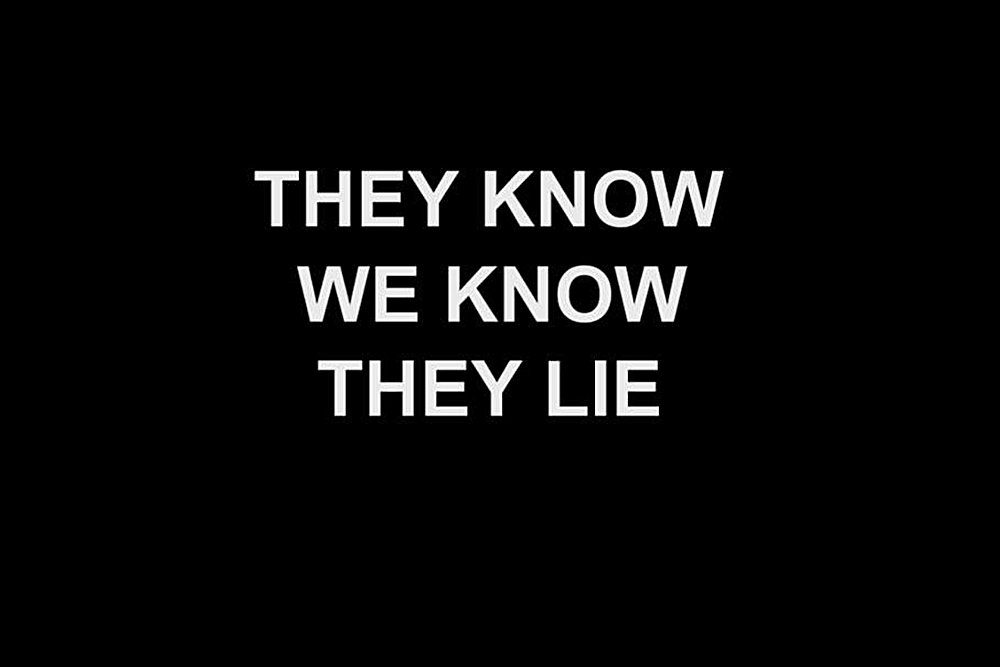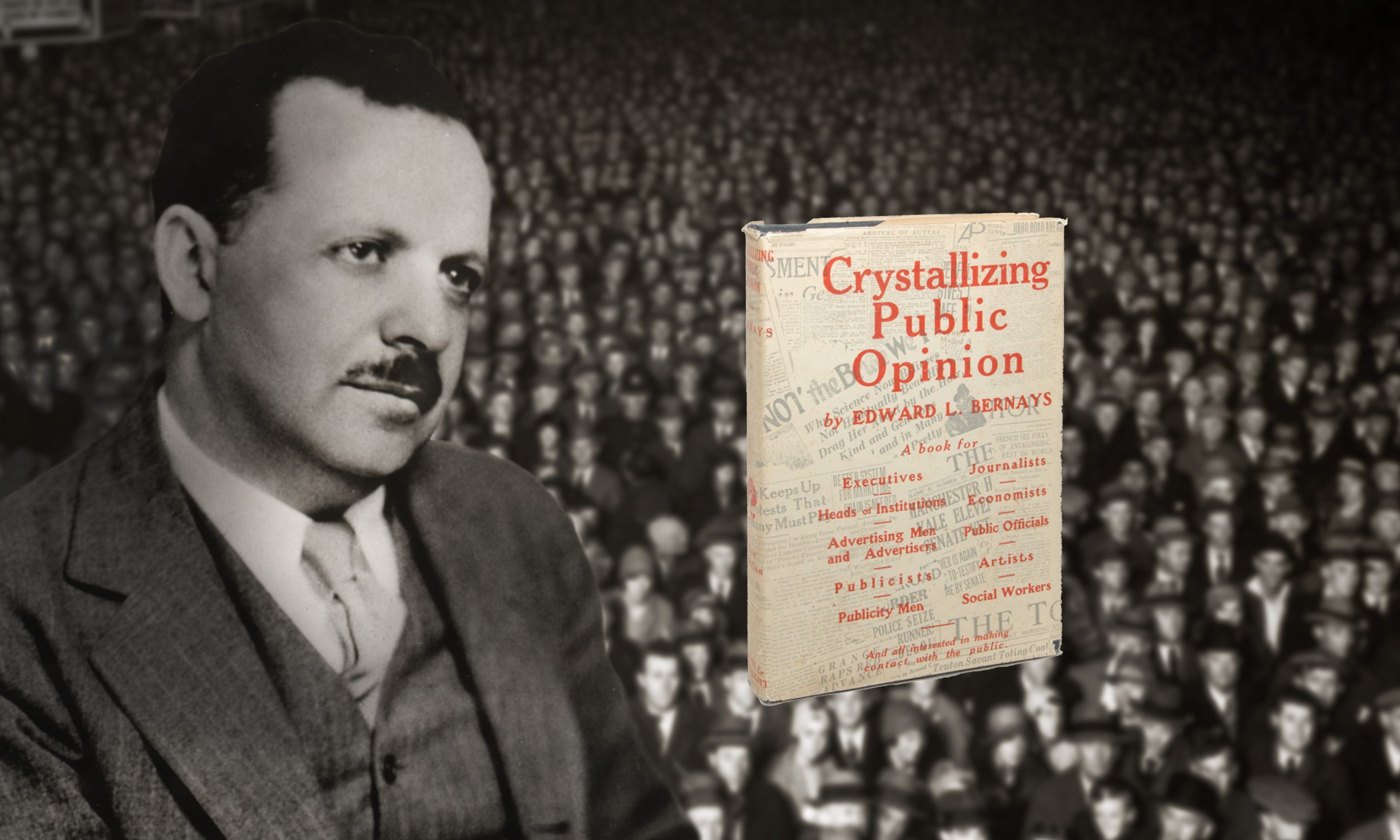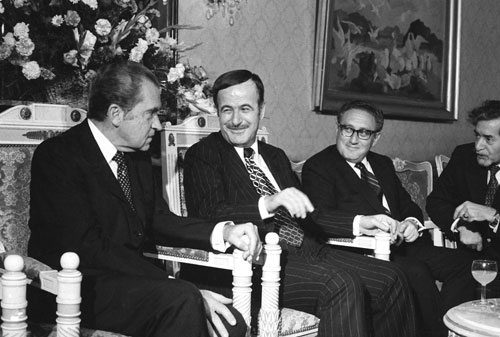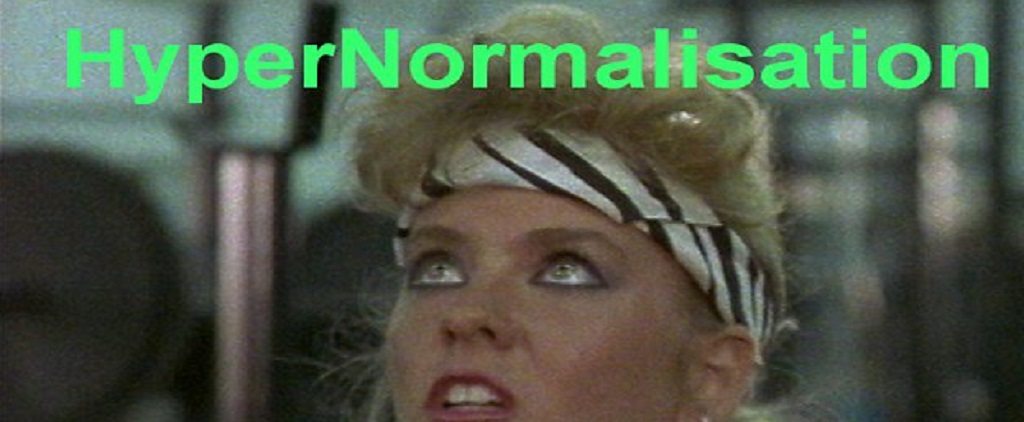[dropcap style=”font-size:100px;color:#992211;”]H[/dropcap]ypernormalisation is the title of a 2016 documentary by Adam Curtis the film was released on 16 October 2016 on BBC iPlayer and is like many other documentaries by Curtis available on YouTube. The term ‘Hyper-normalisation’ Curtis explains in the voice over is borrowed from Alexei Yurchak’s 2006 book ‘Everything was Forever, Until it was No More: The Last Soviet Generation’, the book describes a strange world where fakeness is both obvious to the people yet also the primary organising social force in the absence of anything authentic.

“Yurchak argues that everyone knew the system was failing, but as no one could imagine any alternative to the status quo, politicians and citizens were resigned to maintaining a pretence of a functioning society. Over time, this delusion became a self-fulfilling prophecy and the “fakeness” was accepted by everyone as real, an effect that Yurchak termed hypernormalisation,” Adam Curtis[1]

‘Everything was forever until it was no more’ by Alexei Yurchak
Curtis asserts that real situations are complex and don’t fit neatly into simple narratives favoured by powerful states, who in order to justify their actions and control public opinion in their own countries create and give force to simple narratives (Gaddafi is an example for Curtis of a leader who allowed himself to become this role for America and the west, Curtis also shows clips of the former American president Ronald Reagan talking about god putting the world in the hands of America)

A poster of Gaddafi in Ghadames.
More than this Curtis asserts that this is as much a retreat from complexity and is linked to the idea that politics and specifically politicians can’t really change the world for the better and so stopped trying, preferring instead to manage peoples in the interests of large cooperate power he also states that people are complicit in this, that they can see this yet do nothing about it in an interview he gives the following example,
“If you’re in London, what you see around you is all these new buildings being built and they all look exactly alike. But what you also know about these buildings is that none of us are ever going to be able to afford to live in them. After the financial crash of 2008 there was a wave of money coming into the city that couldn’t go into the stock market, so it went into property instead. These blocks you’re actually looking at are not buildings, they’re blocks of money.” Adam Curtis Evening Standard Interview by Ellen E Jones 2016
Cool is always just a pose
In Hyper-normalisation Curtis uses the example of Patti Smith to account for this lack of direct action. Smith can be seen cruising the dilapidated city scape enjoying its atmosphere and peculiarities, in the context of suffering and in the face of great and indifferent power her activity takes on an unintended (by her) absurdity, Smith an influential American singer ‘experiences’ the city rather than trying to change it her activity is more an expression of her own alternate identity rather than being a result of her commitment to any significant or particular change.

Patti Smith East Village New York City by Judy Linn c.-1969-76
“The key thing about cool is instead of getting engaged politically with groups of other people to whom you have to surrender your identity, we wanted to be self-expressive individuals. Look at the Seventies and Eighties, you had the rise of radical art, music and culture. Somewhere in the Nineties, the politics dropped away altogether and you were left with the ironic, cool distance, the ‘whateva’. Cool irony originally had a political analysis that said, ‘We’re detaching from this and looking at it’. Then it just became ‘We’re detached’ Adam Curtis, Evening Standard Interview by Ellen E Jones 2016
Curtis clearly sees this as a mindset which effects the masses not only the creatives who retreated into this activity but also those who consume their activity a kind of symbiotic apathy.
The Documentary style of Curtis is persuasive and in its self, hypnotic, drawing on the kind of media techniques used to bamboozle for the opposite purpose, this is done with ironic timing and juxtaposition of clips and contexts. Curtis fuses original interviews with film clips and archive footage to make his points, this moving collage is combined with a well informed and authoritative voice over, the voice of Curtis himself which lends the documentaries an authentic tone.
Curtis working from the premise that Hyper-normalisation is both in effect and well-established presents the fake, over simplified narrative favoured by the politicians and then undermines these with reference to facts and alternate views which place these ideas into the wider context of global power.

Still from Hypernormalisation
A convincing example of this is the way that Curtis deals with Syria and with Hafez al-Assad President of Syria from 1971 to 2000 Curtis is clear about the rule of Assad, ‘he was brutal and totally ruthless,’ Curtis is clear though that Assad saw his own brutality as purposeful in changing the middle east while American power represented by Henry Kissinger is committed to maintaining the petty conflicts and general tension that blights the area this he links to Kissinger’s famous interest in systems management and his cold war mentality.
Curtis does not seem to do this in support of Assad but rather to show the highly questionable activities of Western power and in the case of Syria in the self-defeating part foreign policy has taken in the creation of the ‘Human Bomb’ or suicide bomber.
Blinded and Bound
There is an urgent and invigorating sense that the documentary is a kind of antidote to the propaganda which has evolved so quickly since the end of the second world war, there is a convincing attempt to both present a more realistic or whole history alongside showing the new ways that power functions via a combination of old fashioned military force and media manipulation. Looking at other examples of Curtis’s output it’s clear that whatever a viewer feels about the political or moral implications of the work there is at least a description of otherwise hidden techniques of modern propaganda which are increasingly used by states and other powerful institutions to get what they want.
‘In the Century of the Self’, Curtis charts among other things a key shift in advertising where the communication of facts as the key technique to convince people to buy certain goods and services is replaced with a far more potent use of desire, lifestyle and psychological based techniques drawing on wants rather than needs and appealing to identity and aspiration.

Bernays broke the taboo against woman smoking with images like this.
Curtis links this directly to the man who coined the term ‘public relations’ Edward Bernays its self a term deliberately contrived by Bernays to replace propaganda as the word propaganda had gained negative connotations with the masses during the war. Curtis’s power is in his unearthing of little known yet fascinating facts, Bernays was employed by the American president, responsible for his publicity and was via marriage the nephew of Sigmund Freud drawing directly on Freud’s ideas and consulting with an American psychoanalyst Bernays pioneers a publicity stunt and so ‘public relations’ is given its psychological influence eschewing the moral and social responsibility Freud had in mind when developing his ideas about the psyche and finds its way into politics via this man, Bernays little known outside interested circles.

Bernays and his book a must for manipulators.
“We often think of propaganda in terms of its very vivid infamous iconography, such as Nazi propaganda and Stalinist propaganda, but really the most powerful propaganda of the 20th century and the 21st century is insidious. Something we often don’t recognise, something that’s disguised and it comes from two words, public relations, words that were invented by Edward Bernays back at the beginning of the 20th century when he said that the Germans had given propaganda a bad name, he wanted to make it respectable and P.R, public relations has not only made propaganda respectable, I’m talking about P.R used by great power such as states, it has made it both insidious and all powerful,” John Pilger Journalist and activist , 2013 [2]
Here John Pilger the famous journalist and activist is making a similar point the ‘insidious’ nature of public relations is in sharp contrast to the clear and obvious propaganda which springs to mind when the word propaganda is used ‘vivid infamous iconography’ is easily recognised for what it is indeed it was always so, the flyers of the soviets or the Nazis or even the allied forces where always clearly identified as propaganda, public relations is not just a new word obfuscating the true motivation of propaganda (to manipulate people by not giving them all relevant information) it is also a new age of techniques and as such of power much of which is identified by Curtis to undermine that power placing him firmly in the position of an iconoclast.
The feeling of watching a number of Curtis’s works is to be shown a world where people are misled, lied to, fed false images of history and of current affairs a world where the techniques of undermining critical thinking are so effective that direct force at least at home is not even necessary!
We are not cattle we are men! aren’t we?
For Curtis people are treated like cattle or robots made to feel insane or paranoid and isolated, his use of film clips, cartoons and amusing use of editing gives body to the forces which he wants us to see also, for Curtis this trick or betrayal is played again and again for classically hubristic reasons; corrupt powerful people exploiting communities but also and perhaps even more worryingly because the systems like capitalism, corporatism, digital utopianism have simply taken on a kind of truth or inevitability In the ‘Century of the Self’ for example the impression is of a society running out of ideas and doggedly following unfruitful notions in the absence of a better path, the impression at the end of all his works is never simply one of blaming the powerful but of questioning one’s own sympathies and motivations.
The techniques identified by Curtis are harder to recognise and to articulate they are attempts in themselves to subject people to manipulation without the polarizing effect of old iconic propaganda passing the natural resistance people might feel to being told what to do and how to think instead they appeal to desire, hopelessness or they are deliberately confusing, bombarding the senses.
Constructive Ambiguity, what you don’t know will hurt you!
In Hyper-normalisation other than the namesake there are two methods identified; firstly, Constructive ambiguity,[3] a technique used by Kissinger whereby current allies are not directly lied to but led to believe that one strategy or outcome is being pursued while the exact opposite is in fact being pursued this requires a kind of managed non-committal set of activities open to interpretation in this way the public facing officials or politicians are able to say they have not openly lied, maintaining appearances while their intentions or subterfuge is achieved never the less.

President Richard Nixon, left, meets with Syrian President Hafez al-Assad along with Secretary of State Henry Kissinger at the Orient Club in Damascus, Syria, June 15, 1974.
“For those unfamiliar with the term, ‘constructive ambiguity’ is a negotiation technique first employed in the 1970s by Henry Kissinger, the godfather of American diplomacy (as well as the chief architect of today’s Middle East peace process); it is premised on the belief that ambiguously worded text can create opportunities for advancing the interests of both parties to a negotiation. This concept became the hallmark of the Oslo Accords, along with the numerous protocols, memorandums and other micro-initiatives derived from it,” Khaled Elgindy, ‘When Ambiguity is Destructive’ Brookings Edu, 2014
Elgindy writing in The Brookings Institution website is clear that in the middle east this technique,
“has succeeded only in producing confusion and eroding trust between the parties,” ibid
In this sense Elgindy is with Curtis that ultimately such a method is negative while Curtis pushes further hinting at the controlling and deceit of Kissinger himself.
Perception Management
The second method identified in Hyper-normalization is Perception Management,
“Perception Management is a Propaganda technique that involves carefully altering the perceptions of a target audience to suit the objectives of the sponsor, and is an essential part of modern Information Warfare. The term originated within the U.S. Military as part of their Psyops program, describing how selective information is provided (or denied) to a target audience to influence their emotions, motives and objective reasoning in order to promote a change in behaviour that is favourable to the sponsor,” Department of Defense (2001), “Department of Defense Dictionary of Military and Associated Terms”, Joint Publication 1-02, 12 April 2001 (As Amended Through 17 December 2003)
In Hyper-normalisation Curtis gives the surprising example of the American secret services UFO activities where by individuals where fed false information convincing them that aliens and alien activity was not only taking place but also being hidden by the government Curtis includes a depressing interview with a government agent where the agent explains even after revealing everything to the target all the games and effects that even then they still clung to falsehood convinced they were being lied to, this among other activities act as a kind of distraction, the Centre for Research on Globalisation puts it like this.

UFO California 1970s
“Perception Management” was pioneered in the 1980’s under the Reagan administration in order to avoid the public opposition to future wars that was seen during the Vietnam War,” Kenneth G. Eade, “Perception Management”: How to Sell a War 2016 [4]
Going on to identify a number of methods,
“Alvin and Heidi Toffler cite the following as tools for perception management in their book, War and Anti-War:
- accusations of atrocities;
- hyperbolic inflations;
- demonization and dehumanization;
- polarization;
- claim of divine sanction; and
- meta-propaganda” Ibid
Eade makes an interesting point later in his article where he simply reveals that,
“Private contractors, such as Steele, were often subject to different rules than the military forces they served and, in some cases, served with. As of 2008, an estimated 155,286 private contractors were employed by the US on the ground in Iraq, compared to 152,275 troops. The estimated annual cost for such contractors ballooned to $5 billion per year by 2010,” Ibid
It is a shocking thought that just over half the army were counted as private contractors and as such subject to different rules, the idea of mercenary troops is simply not any part of the public perception of the armed forces as a patriotic embodiment of national values the managed view of the army just does not include that fact.[5]
In 2014 Curtis, produced the short ‘Oh Dearism’ for BBC’s “2014 Wipe”[6] with Charlie Brooker there in he describes the all-pervading trend in the media to present an endless set of horrendous events where by the audience is beaten into a sense of hopeless impotence,
“So much of the news this year has been hopeless, depressing, and above all, confusing. To which the only response is to say, “oh dear.” What this film is going to suggest is that that defeatist response has become a central part of a new system of political control…… It sums up the strange mood of our time, where nothing really makes any coherent sense. We live with a constant vaudeville of contradictory stories that makes it impossible for any real opposition to emerge, because they can’t counter it with any coherent narrative of their own. And it means that we as individuals become ever more powerless, unable to challenge anything, because we live a state of confusion and uncertainty. To which the response is: Oh dear. But that is what they want you to say” Adam Curtis, 2014 Wipe BBC 2014
Agent of Manipulation
While this is an effect of all pervading 24hr media culture and our individual morbid addiction to violence and sensationalism Curtis points out that it is also becoming a key aspect of political control he gives two examples of ways this effect can be processed into a clear and effective strategy, the first is the way Russia is conducting its activities in Ukraine under the guidance of Vladislav Surkov who Curtis claims is operating a non-linear war.

Vladislav-Surkov pictured in toprichests.com
“He came originally from the avant-garde art world, and those who have studied his career, say that what Surkov has done, is to import ideas from conceptual art into the very heart of politics. His aim is to undermine peoples’ perceptions of the world, so they never know what is really happening. Surkov turned Russian politics into a bewildering, constantly changing piece of theater. He sponsored all kinds of groups, from neo-Nazi skinheads to liberal human rights groups. He even backed parties that were opposed to President Putin. But the key thing was, that Surkov then let it be known that this was what he was doing, which meant that no one was sure what was real or fake. As one journalist put it: “It is a strategy of power that keeps any opposition constantly confused,” Adam Curtis, Ibid
Curtis describes how the purpose of non-liner war is never to win the war but simply to keep everyone engaged in the activity and to undermine perception making it impossible to counter, he goes on to draw comparisons to the then British chancellor George Osborne and his handling of the economic crisis describing Osborne as a shapeshifting postmodern politician,
“A vast majority of that money has actually found its way into the hands of the wealthiest five percent in Britain. It has been described as the biggest transfer of wealth to the rich in recent documented history. It could be a huge scandal, comparable to the greedy oligarchs in Russia. A ruthless elite, siphoning off billions in public money. But nobody seems to know,” Adam Curtis, Ibid
Curtis exposes a deeply cynical world where powerful institutions and manipulative agents (millionaires, business men, politicians, secret servicemen) conspire to frustrate, prevent and ultimately destroy the potential for change, mainly by marshalling all the forces of modern art, entertainment and news media to attack the individuals sense of reality and their ability to perceive danger and control.
The Cave of today has walls of light
It is truly an abhorrent activity that Curtis describes the exact opposite of education and empowerment that this is normalised in our time is a great shame and Curtis goes some way to reinstate the shock and disappointment we should feel.
In the famous allegory of the Cave Plato has Socrates state,
“Better to be the poor servant of a poor master, and to endure anything, rather than think as they do and live after their manner,” Plato

diagram of platos cave, the shadows are all to the prisoners.
Socrates is referring to way a person would feel having been shown the true nature of the prisoner’s life and how one would balk at the thought of having to take up a place again as a prisoner of that illusion in the cave. Plato and as he would have it, Socrates are agents of enlightenment and empowerment it is surely the lowest of the low, worse than even the cave dwellers fixated by a falsehood to be an agent of the cave, to actively want the ignorance, ineptitude and apathy of your fellow man something worse than even Plato could imagine when he wrote about the piteous plight of the prisoners in the cave, such an agent is an agent of destruction and must be the true definition of misanthrope, having imbibed much of Curtis’s work I can’t think of a worse kind of human than that.
____________________________________________________
Notes
[1] Adam Curtis (16 October 2016). “With documentary film-maker Adam Curtis”. Jarvis Cocker’s Sunday Service (Interview). Interview with Jarvis Cocker. London: BBC Radio 6 Music. Retrieved 17 October 2016
[2] Pliger is speaking as one of a group of experts about the nature of propaganda in a clip from an exhibition at the British Library called, Propaganda: Power and Persuasion the exhibition ran from the 17 May until 17 September 2013. These interviews were published on Jun 3, 2013 on YouTube at, https://www.youtube.com/watch?v=_uVGLCgqptI
[3]A list of Kissinger’s use of this to effect on the world stage can be found here, https://en.wikipedia.org/wiki/Constructive_ambiguity There are also a number of contemporary stories which concern David Davis’s use of the term in relation to Brexit one such is available here, https://www.libdems.org.uk/constructive-ambiguity-is-code-for-we-don-t-have-a-clue
[4] Information available here https://www.globalresearch.ca/perception-management-how-to-sell-a-war/5534299
[5]More information from an alternative source about America’s use of mercenary troops can be found here, https://www.theatlantic.com/international/archive/2016/08/iraq-afghanistan-contractor-pentagon-obama/495731/
[6] The short can be viewed here, https://www.realclearpolitics.com/video/2016/10/12/bbcs_adam_curtis_how_propaganda_turned_russian_politics_into_a_circus.html
_____________________________________________________
References
Charlie Lyne, Hypernormalisation: Adam Curtis plots a path from Syria to Trump, via Jane Fonda, Guardian online, 2016. https://www.theguardian.com/tv-and-radio/2016/oct/15/hypernormalisation-adam-curtis-trump-putin-syria
Ellen E Jones, ‘From Brexit to Donald Trump: welcome to the age of hypernormalisation in London’ Evening Standard 2016. https://www.standard.co.uk/lifestyle/london-life/from-brexit-to-donald-trump-welcome-to-the-age-of-hypernormalisation-in-london-a3367326.html
Propaganda: Power and Persuasion the exhibition ran from the 17 May until 17 September 2013. These interviews were published on Jun 3, 2013 on YouTube at, https://www.youtube.com/watch?v=_uVGLCgqptI
Khaled Elgindy ‘When Ambiguity is Destructive’ Brooking Edu January 22, 2014, https://www.brookings.edu/opinions/when-ambiguity-is-destructive/
Tim Hains, ‘BBC’s Adam Curtis: How Propaganda Turned Russian Politics Into Theater’ Posted on October 12, 2016, https://www.realclearpolitics.com/video/2016/10/12/bbcs_adam_curtis_how_propaganda_turned_russian_politics_into_a_circus.html

Natalie Andrews is an artist working with a range of mediums, she has shown her work at the Hoxton Arches in London and is currently working on a number of 3d works alongside painting exploring the links between painting and sculpture;
“I am interested in the way that we relate to one another and with space, how the environments we inhabit structure and dictate these relationships and create both opportunities for emancipation but also the deep alienation and separateness.”




















